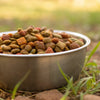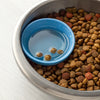How Long Does Dry Dog Food Stay Fresh Once Opened? Essential Insights for Pet Owners
- Houndsy
Table of Contents
- Introduction
- The Shelf Life of Opened Dry Dog Food
- Identifying Spoiled Dry Dog Food
- Proper Storage Techniques for Dry Dog Food
- Common Mistakes to Avoid
- How to Extend the Freshness of Dry Dog Food
- Health Risks of Feeding Expired Dog Food
- Ensuring Nutritional Quality and Freshness of Dry Pet Food
- Conclusion
Introduction
As devoted pet owners, we all want to ensure that our furry friends receive the best nutrition possible. Did you know that the way we store their food can significantly impact its freshness and safety? A staggering number of dog owners may not realize that dry dog food – a staple in many households – begins to lose its quality shortly after being opened. So, how long does dry dog food stay fresh once opened?
In this blog post, we’ll explore the crucial aspects of dry dog food storage, including shelf life, signs of spoilage, and the best practices for keeping your dog’s food fresh. By the end, you’ll have a complete understanding of how to enhance your pet's feeding experience and ensure they receive nutritious meals every day.
We’ll dive into the specifics of dry dog food storage, including the factors that affect its shelf life, proper storage techniques, and common mistakes to avoid. Moreover, we’ll discuss how to extend the freshness of your dog’s food while keeping their health and well-being at the forefront of our conversation.
So, let’s embark on this journey together and reflect on our own pet feeding routines. Are we doing everything we can to keep our beloved companions healthy and happy?
The Shelf Life of Opened Dry Dog Food
When we open a bag of dry dog food, its freshness begins to decline. It’s essential to understand that while the packaging may provide a "best by" date, this is primarily an estimate of how long the food will remain at peak quality before opening. Once opened, we recommend aiming to use the food within 4 to 6 weeks for optimal freshness and nutritional value.
Why Does Freshness Decrease After Opening?
The decrease in freshness after opening is influenced by several factors, including exposure to air, light, temperature, and moisture. Each time we open the bag, we introduce air into the packaging, increasing the likelihood of oxidation, which can lead to rancidity and spoilage.
Importance of the "Best By" Date
The "best by" date is not an expiration date but rather a guideline for when the food is expected to maintain its best quality. Understanding this distinction helps us manage our dog’s food supply effectively, reducing waste while ensuring our furry friends receive high-quality nutrition.
Identifying Spoiled Dry Dog Food
Knowing how to identify spoiled dry dog food is crucial for your pet's health. Here are a few signs to look out for:
- Change in Smell: A rancid or unusually strong odor is a clear sign that the food may have gone bad. Fresh dry dog food should have a pleasant, mild smell.
- Visual Changes: Look for any signs of mold, discoloration, or strange particles mixed in with the kibble. If the kibble appears darker or has developed a powdery texture, it’s best to err on the side of caution and dispose of it.
- Texture Alterations: If you notice any hard, crumbly pieces or moist clumps, the food may have absorbed moisture, leading to spoilage.
If you notice any of these abnormalities, we should dispose of the food immediately. Our pets deserve the best, and it’s essential to prioritize their health and well-being.
Proper Storage Techniques for Dry Dog Food
To ensure the freshness of our dog’s dry food, we must store it correctly. Here are some effective storage techniques:
1. Store in a Cool, Dry Place
Temperature plays a significant role in the freshness of dry dog food. We should keep it in a cool, dry area, ideally below 80°F (27°C), away from direct sunlight and humidity. Excessive heat and moisture can accelerate spoilage and degradation of the food.
2. Use Airtight Containers
Investing in a quality airtight container is one of the best ways to protect our dog’s food. A hard-sided, airtight container prevents air, moisture, and pests from entering, thereby preserving the kibble's freshness. If we choose to keep the food in its original bag, we can place it inside the container for added protection.
3. Avoid Frequent Opening
Every time we open the container, fresh air enters, which can speed up the deterioration of the food. To minimize this effect, we can consider using smaller containers for daily use while keeping the bulk of the food sealed away.
4. Check Expiration Dates Regularly
It’s essential to check the expiration date before purchasing and feeding our dogs. Buying smaller quantities that our pets can consume within a reasonable timeframe helps ensure the food remains fresh.
5. Maintain Cleanliness
When scooping food, we should ensure that our hands, scoops, and bowls are clean to avoid introducing bacteria or moisture. Contaminants can lead to spoilage and health risks for our pets.
6. Store Away from Strong Odors
Dry dog food can absorb odors from its environment, affecting its taste and quality. We should keep it away from areas with strong smells, such as cleaning supplies or garbage.
Common Mistakes to Avoid
Even with the best intentions, we can make mistakes that compromise the freshness of our dog’s food. Here are some common pitfalls to avoid:
- Leaving Food in Original Packaging: While many bags are designed to keep food fresh, they aren't foolproof once opened. Consider transferring the kibble to an airtight container for added protection.
- Not Sealing the Bag: If we choose to keep the food in its original bag, it’s vital to seal it tightly after each use. Clips or vacuum sealers can help remove excess air before sealing.
- Ignoring Signs of Spoilage: We must always be vigilant about checking for signs of spoilage before feeding our pets, as stale or contaminated food can lead to health issues.
How to Extend the Freshness of Dry Dog Food
Fortunately, there are several ways we can extend the freshness of our dog’s dry food beyond the initial 4 to 6 weeks:
1. Use Desiccants
Adding desiccant packets (silica gel packs) to the storage container can help absorb excess moisture, keeping the food dry and fresh for longer.
2. Refrigeration
For some dog owners, storing dry dog food in the refrigerator can be beneficial. While it may not be necessary, it can help maintain a consistent cool temperature, especially in warm climates.
3. Portion Control
To minimize exposure to air, consider dividing the food into smaller, portion-sized bags. This keeps the bulk of the food sealed and protected while allowing easy access to daily servings.
4. Choose Quality Brands
When selecting dry dog food, consider purchasing from reputable brands that prioritize quality ingredients and packaging. High-quality kibble often has better shelf stability and longer freshness.
Health Risks of Feeding Expired Dog Food
Feeding our dogs expired or spoiled food can pose serious health risks. Here are some potential dangers:
- Nutritional Deficiencies: Expired food loses its nutritional value, which can lead to deficiencies in essential vitamins and minerals over time.
- Bacterial Contamination: Old or spoiled food can harbor harmful bacteria such as Salmonella or E. coli, which can cause severe gastrointestinal issues in dogs, leading to vomiting, diarrhea, and more serious complications.
- Rancid Fats: The fats in dry dog food can become rancid, leading to digestive problems and potentially toxic reactions in our pets.
It’s crucial to prioritize our dog’s health by ensuring their food is fresh and safe.
Ensuring Nutritional Quality and Freshness of Dry Pet Food
To maintain the nutritional quality and freshness of our dog’s dry food, we can implement the following strategies:
- Store in a Cool, Dry Place: As mentioned, temperature and humidity are critical. Keeping food in a controlled environment helps maintain its quality.
- Check Expiration Dates: Regularly review the expiration dates and plan purchases accordingly.
- Avoid Contamination: Always use clean tools and containers when handling dog food.
- Consider Quality Over Quantity: Investing in high-quality dog food can yield better nutritional outcomes and longer shelf life.
Conclusion
In summary, the freshness of dry dog food is influenced by various factors, including storage conditions, exposure to air, and the original packaging. As responsible pet owners, we can extend the shelf life of our dog’s food and ensure their health by following proper storage techniques and avoiding common mistakes.
By prioritizing our pets’ nutrition and well-being, we not only enhance their feeding experience but also strengthen our bond with them. So, let’s take a moment to reflect on our current pet feeding routines. Are we doing everything we can to keep our furry friends healthy and happy?
As we explore ways to elevate our dog feeding experience, consider checking out the Houndsy Kibble Dispenser, designed with modern aesthetics and functionality in mind. This innovative product not only simplifies the feeding process but also ensures that every meal is served fresh and at the perfect portion.
FAQ
How long does dry dog food stay fresh once opened?
- Generally, dry dog food should be consumed within 4 to 6 weeks after opening for optimal freshness.
What are signs that dry dog food has gone bad?
- Indicators of spoilage include off odors, discoloration, moisture, and changes in texture.
How should I store opened dry dog food?
- It’s best to store dry dog food in an airtight container in a cool, dry place to maintain its freshness.
Can I freeze dry dog food?
- While not necessary, dry dog food can be frozen in airtight containers for extended freshness, but it should be used within a reasonable timeframe once thawed.
What health risks are associated with feeding expired dog food?
- Expired dog food can lead to nutritional deficiencies and exposure to harmful bacteria, potentially causing serious health issues in dogs.
Remember, our pets rely on us for their health and happiness. Let’s ensure we’re doing everything we can to provide them with the best nutrition possible!












